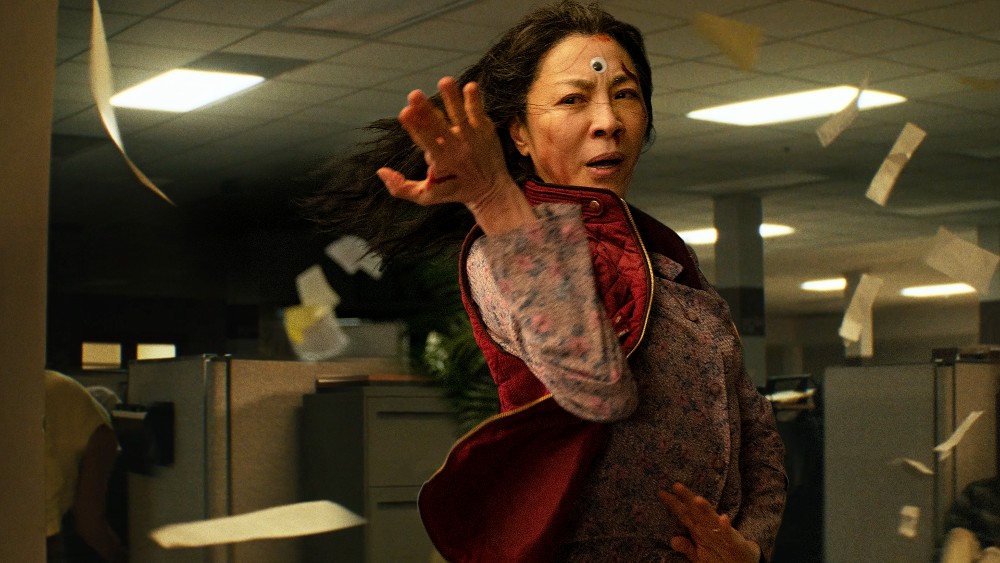
The eccentric visuals and impressive martial arts sequences in Daniels’ new A24 movie Everything Everywhere All at Once required a lot of work, both in pre-production and post, but it’s the latter where things really came together.
Rather than go with a big VFX house as they did with their previous feature, Swiss Army Man, the directing duo of Dan Kwan and Daniel Scheinert instead called upon their longtime friend and fellow filmmaker, Zak Stoltz, to act as the film’s overall VFX Supervisor after working with him on several music videos early in their career.
Stoltz then tapped Ethan Feldbau, who brought his own specific skill set as a filmmaker and production designer to the table, to serve as the film’s Lead Visual Effects Artist along with Ben Brewer (also a director in his own right). Eventually, Jeff Desom, who has also directed many shorts and music videos, was brought on to help the team get through the intense workload. He’s one of four visual effects artists credited along with Evan Halleck, Kirsten Lepore, and Matthew Wauhkonen.
Below the Line jumped on Zoom with Stoltz, Feldbau, and Desom to discuss how the three of them worked with Daniels to produce the impressive number of visual effects needed to make Everything Everywhere All at Once as seamlessly as it does.

Below the Line: I know that, like DP Larkin Seiple, you’ve been working with Daniels since their music video days. Was “Turn Down for What” fairly early on in your collaboration with them?
Zak Stoltz: That was actually fairly late in our long history. I think the first project I worked with them on was Pockets, a short film they did, probably in 2012. I had met them at a random event, and I thought their stuff was cool. I thought, ‘Hey, I make stuff that’s kind of crazy like this, too,’ because I was also directing. I sent them one of my short films. They were like, ‘Hey, great! Cool! We really need help on some visual effects. Can you come help us out?’ That just started a relationship where I just came on to help them with a couple things, and then they’re like, ‘Do you just want to hang out?’ so we would just hang out.
We ended up working on a bunch of music videos together. I remember, specifically, the Tenacious D music video that we worked on together. It was just me and them and Ben Brewer, who was also one of the lead visual effects artists on this film, [and] who was living with Dan Kwan at the time. We were all just living in Dan Kwan’s bedroom, and I brought a foldable table and my computer, and we were just sleeping under the desk during renders. That just became kind of the basis for how the rest of everything would unfold. It was a very DIY system that we built. [At this point, Ethan Feldbau pops into the Zoom] And this is Ethan. Ethan was one of our lead visual effects artists and responsible for all the graphic user interfaces and a lot of the design elements and a bunch of stuff in the movie. There are only five of us who did Everything, so…

BTL: Ethan, how did you get involved? Had you worked with Zak on other things before this?
Ethan Feldbau: It’s kind of [in a] funny, roundabout way where I’ve been hovering around everybody for a long time. I actually went to college with the Daniels many years ago at Emerson College. I met Dan Scheinert maybe 15 years ago because both of our films were in the Emerson LA Film Festival together. Dan Scheinert had made a film with Tallie Medel, who plays Becky in the movie. We moved out to L.A. shortly after. I became a production designer for some of the Daniels’ early work. For a little while, we went our separate ways. I met Zak, and Zak became a friend, and we started to do visual effects together. I did a show with Zak that he had directed called Breakarate. Because of that working relationship, and because the Daniels were starting up on this movie and needed some friends, Zak thought to pull me on. Unbeknownst to Zack, I already had this past with the Daniels, so we kind of came full circle.
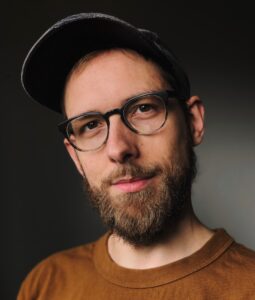
BTL: Jeff, we’re just doing introductions, so maybe you can say how you got connected with Zak and Daniels to get involved with this movie?
Jeff Desom: Yeah, I knew everyone. I mean, this goes like 10 years back when we all started out. I think Vimeo was pretty big at the time, and I saw the Daniels’ work through Vimeo. And I think they saw myself from Vimeo. They occasionally would ask me to do the effects for their music videos. I think it only happened on one occasion, and ever since, we’ve kind of grown up alongside each other, and I met Ethan and Zak along the way, and we’ve worked in various capacities with each other. Ethan’s a director, and he’s a production designer, so I would have him production design some of my music videos, and Zak, it’s the same thing. For this, we all sort of gathered together to create the VFX team.
BTL: I’ve spoken to a ton of VFX supes and I know that Daniels went the VFX house route with Swiss Army Man, but for this one, it was a really small team.
Stoltz: We had five people who did over 80 percent of the over 500 visual effects shots, so it was a very small team, and it was really bespoke. It was hiring people as we needed them. Dan and Daniel originally came to me, because we had such a long working relationship together, and they were like, ‘We would love to be more hands-on. We want to do this like we’ve done music videos,’ because they didn’t love the process of working with a big VFX house. It wasn’t that they weren’t happy with the work; it’s just that they really like to get in there. The big thing they wanted was to be able to work with the artists. I came on just to help build out the whole process and figure out, ‘Okay, how do we do this in a way that is with a small team?’ There’s a big ignorance component to it because I don’t know what a big VFX supe does, because I’ve never worked in that environment. I’ve only done this particular way. It was building this process from the ground up and bringing people on for their varied skills and abilities. Ethan has a ton of skills that I don’t have.
Jeff has a ton of skills that I don’t have. We all filled a particular role in this, but we also were able to pass projects back and forth between us and then also pass it over to Dan Kwan for something. And then, Scheinert would do some stuff himself. One of the reasons that we didn’t have a bigger team was, one, we didn’t need it, but also, it would have been really hard to manage more people. This is my first rodeo, as it were, managing a team of visual effects artists.
Like Jeff said, we’re all directors — that was our main thing — and then, we just learned visual effects because we wanted to do [them] for our own projects, so how do we figure that out? That was the mentality that everyone brought to the table, which was just like, ‘We don’t really know how to do this, but we’re going to figure it out, and we’re going to make sure that it’s good,’ because we all have taste… or at least we think we do. [laughs]
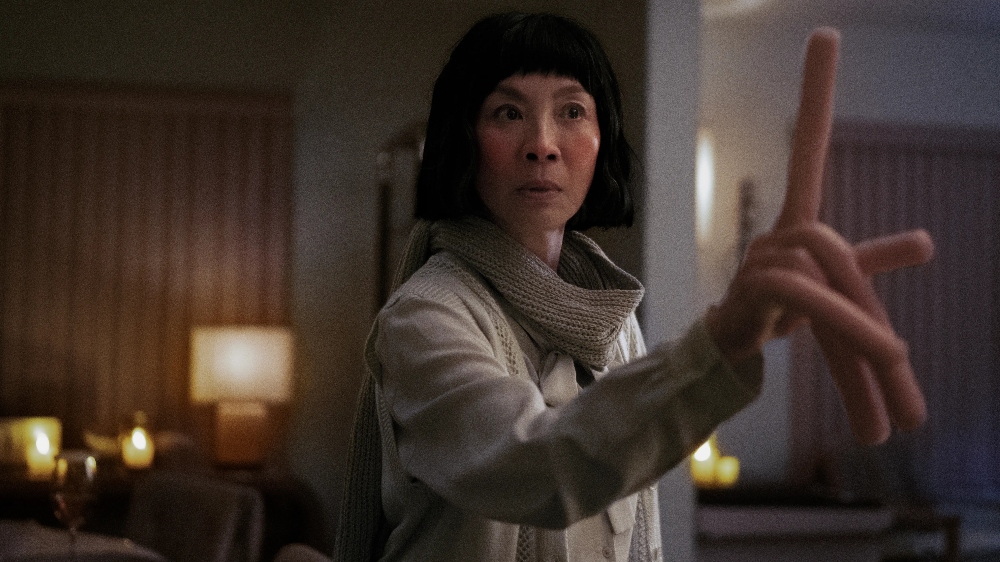
Feldbau: If I could throw in one thing about the difference between Swiss Army Man and this: the effects in Swiss Army Man were a little more objective. They had a very clear task, mostly to help the magic of Manny [the dead body portrayed by Daniel Radcliffe] happen. For visual effects, that was taking out the gimmicks. This was their first film that had what I call expressionism in it. They had to communicate thoughts, ideas, and feelings, to design things, to figure out how they should look. It was much more emotional, much more subjective, and the process of going to a larger house is having to communicate with lots and lots of people. Unfortunately, what happens is the message gets a little bit muddled, and you play a game of telephone. They were hoping that they could speak directly to some close friends who had some legacy with them and could kind of read their minds a bit.
Stoltz: I feel like it’s a very uncommon process. It was common for us, but how often does the entire visual effects team get to hop on a Zoom with the directors and go over all the shots that they did that week? That doesn’t seem like a thing that happens, and that’s what we did. We were all doing this remotely, and we were just like, ‘Okay, we’re hopping on a Zoom, and we’re just gonna go through the shots, talk about them. We’re gonna draw on them and do all this stuff.’ It was just doing that with the directors, so there was no telephone. Every now and then, I would relay notes, but if there was ever any question or anything we needed to talk to them about, it was like, ‘Alright, we’re just gonna talk to them and figure this out together.’
BTL: Were you dividing shots from when you first got the script, which I imagine had to be fairly early on before shooting? So were you splitting shots between you that early or was it more in post where you were passing things around?
Stoltz: It was a combination. There was a lot of stuff that during pre-production and during production, Ethan was on board helping with all the user interface stuff, because there’s a lot of that stuff that we were shooting on set and things we needed to know, like, ‘What’s the actual layout? What does this generally look like?’ That was a lot of stuff that was developed beforehand, so we knew that Ethan was going to be handling most of that stuff.
Originally, it was just me and Ethan, and then we brought on Ben, who helped out with a lot of the bagel R&D stuff. And then, Jeff came on afterward, a bit later in the process. We brought people on as it became clear that we had too much to do among the smaller team, and then we’d be like, ‘There’s too much going on in life. Oh! Jeff would be really good at this thing.’ We’ve known Jeff forever, so it just became this very fluid thing where sometimes someone would start with a shot, and then it would become clear that, ‘Oh, we really need Ethan to focus on this other thing. Let’s pass this thing over to Jeff,’ or ‘Jeff was working on this thing, but we really need him on this thing. Let’s just shift things.’ We’d be passing stuff back and forth a lot, and just adding our own little stuff to it.
Feldbau: We have different skill sets, too, and that defined what shots we might get handed. Something more art and design-oriented might go to me. Something more 3D-oriented might go to a Ben or a Jeff. We started to realize how diverse the team was. Unfortunately, we all cover the gamut, the spectrum of all the things that needed to be done, but it just became sort of dividing who got what.
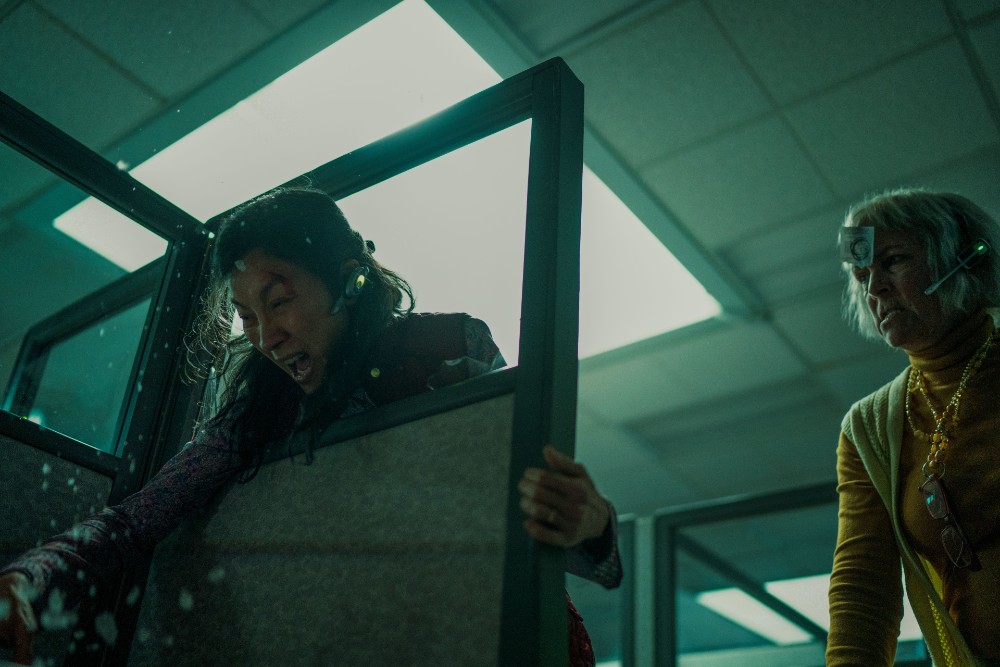
BTL: Is one of you better on the animation side of things?
Stoltz: Jeff has a great visual effects breakdown that he did of this hibachi thing with all the food. It’s on his Instagram — it’s very fun.
Feldbau: Truly hand-animating that versus letting a computer do the physics for him, so that’s Jeff’s brain at work there.
BTL: Can you talk about that a bit, Jeff?
Desom: It was actually the first shot that was handed to me. It was sort of a warm-up where Zak was like, ‘Try this. See what you can do.’ [The shot] was Harry Shum, Jr. just pantomiming to be this crazy, insane, talented, hibachi chef, and there was nothing there. It was just him doing all these crazy movements and bouncing something into people’s mouths from the spatula. I just had to figure out what was going to be there. Usually, one way to do that is to create the assets or you buy a few vegetables as 3D assets, and you light them, you texture them so that they fit into the scene seamlessly. And then, you have physics simulate the gravity of them and in what arc they would fly. All of that seemed so complicated. I just decided to do it in 2D, like you would paint a cartoon. That gave me such a great deal of control. I could say, ‘Okay, there he hits shrimp, so I’m going to draw the arc this shrimp is going to fly in.’ It’s far enough away that I can get away with it just being a blip on the screen with a bit of shadow, a little highlight and with motion, nobody would ever notice that I didn’t go down a 3D route where everything is physically accurate.
BTL: Zac, did you do pre-vis for anything? There are a lot of action shots and scenes where you have to put together a lot of shots and make them work seamlessly.
Stoltz: Nothing was pre-vised. [laughs]
Feldbau: We did have a point while the edit was happening, and while we were in lockdown, that a lot of concepting was being done, but it wasn’t for everything. We were very select… [I was] tasked with coming up with style frames and illustrations that might help, and then you start a conversation with the directors, and they could give notes.
Stoltz: Also, a big part of the Daniels process is they are so hands-on, they’re so used to doing everything themselves that a big part is this idea of like not knowing it until you see it. Things are always changing. The edit was changing constantly. Some effects that we created were changing constantly. In a lot of ways, pre-vis would have locked us into something that ultimately would have changed anyway. There would be ideas that would come in late in the game where we’d have a shot that was close to being done, and it would be like, ‘Oh, what about this? What if we tried this?’ There’s a lot of iterating and that was a big part of why this process was a big deal for them in the first place. If you were to basically have a finished visual effects shot out of a big house and they’d be like, ‘Alright, we’re done,’ and they’re like, ‘Let’s try something completely different.’ That’s a whole can of worms. For us, it was just like, ‘Oh, cool. Daniel can take the project real quick and sketch out what you’re thinking and pass it back,’ and then we’ll get in and organize that stuff and work off that. That was simple.
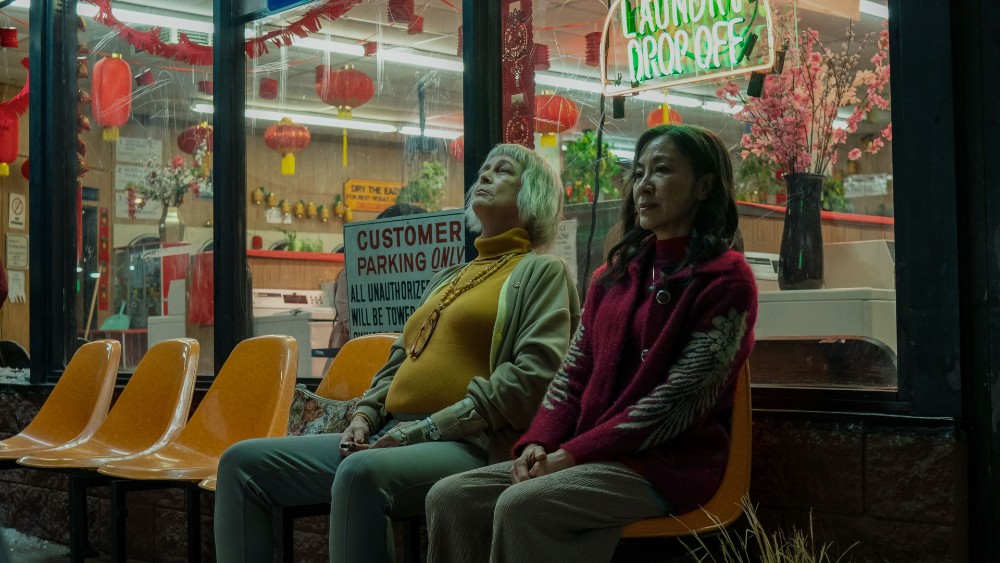
BTL: Paul Rogers mentioned there were many different edits of the movie, so how does that affect what your team is doing with the visual effects when things might be changing with the edit?
Feldbau: We might have done something that hasn’t been done. I’ll paint a picture for you. Originally, we were supposed to work under the same roof as editorial. We were all going to be together, we were going to be working in tandem with Paul Rogers, our editor, and being able to hang out and speak directly with the Daniels. All of a sudden, this very intense movie shuts down, because we don’t know what’s really going on. We’ve got a pandemic, there’s a lockdown, and we can’t all be together. So, how do you make this remote and how do you work with the editorial? That was a real challenge for a while. Fortunately, Zak and his brain were able to piece together a way for us to all be at home, without network-attached storage, all working together. Zak can go into it a little bit more, but he found a way for us to have qualities of a real post house that allowed us to work independently, learn to share through Frame.IO and Dropbox, have Zoom meetings, and come up with a way to communicate with editorial, so we could basically be doing effects while they were auditioning them in the edit. And then we would all converse about how to reshape what was and wasn’t working. Do you want to elaborate?
Stoltz: I could, but a lot of it was Paul just shooting me a text message, and just being like, ‘Hey, we want to do this thing. Can you help us with this?’ I’ve known Paul for years — he’s edited one of my short films. The fact that Paul and Dan and Daniel knew what was possible with visual effects really changed the way that it was edited, as well. There’d be certain things like, ‘Let’s just do a split-screen here. It’s not perfect, but we’re gonna have visual effects help with this thing.’ Just add more work to our plates, but it was fine, cause we’re all friends. There was one moment that I don’t think has been mentioned too much. There was a whole scene where we had to remove a character from the entire scene, and that fell on Jeff. It was a lot of moving shots, but it ended up working out great. You’d never know.
BTL: I’ve heard from many different people about doing post during the pandemic, but also about how the lockdown offered the odd blessing of there not being as much going on. Were you able to at least keep decent work hours on when you were doing this and maybe get weekends off?
Stoltz: It was very structured in [terms of] time. The expectation was just an eight-hour workday. It was really just a certain number of hours per week, and once you went past that, you were in overtime. I tried to be very flexible, especially towards the end. “If you feel like you’re not going to be productive on a day, just go outside. We’ll get it done. There are going to be times where it’s going to pick up but we have to stay sane throughout this process.”
Feldbau: It was very special. Initially, we were going to have a very quick turnaround in post. It’s funny to say that we got lucky with the fact that we had lockdown and the entire calendar changed. I don’t think if we had been afforded that amount of time, and how gracious A24 and [the Russo brothers’] AGBO were to keep a skeleton crew running, while they figured out what they were going to do with the movie that we would have polished it in the way that we were able to. There’s a little bit of luck and circumstance in addition to everyone’s efforts and talent that made this the really rare, one-off work of art that it is.
Stoltz: Even if we were to do this sort of process again, it would never be the same. The pandemic really was something that, looking back on it, I haven’t really thought about it too much, but that was a time when everything was so crazy for everyone, and we were just heads down making this thing. There was such an intense focus I don’t think there was a lot of attention paid, at least not by me, to the external pressures. Just the fact that getting groceries was this anxiety-inducing thing early on, but we were also making this movie. I think we just poured a lot of that into the movie without even realizing it. At least that’s how I feel about it.
Desom: I came in a bit later, so when I joined, they almost came out with the vaccine. [laughs] It’s true. The whole working from home and all that, it really played into our hands, and we used it to our advantage.
Feldbau: I really would have liked a pizza party with everybody. Just hanging out, we could have talked about the movie. To lose that closeness made this a very unique experience. Films are communal, and it just had to happen in a different way here.

BTL: Paul told me about doing Zoom test screenings with friends, so were you guys on any of those Zooms to see the reactions to stuff?
Desom: I remember being on one of those. They did a cut where they did something radical to it, and it kind of didn’t work, and they quickly changed it again, after that test screening, I remember, because everybody was so confused by it. That’s all I remember from it, but you could tell that… I saw where my work would fit into the bigger piece, and you could tell it was going to be something very special nonetheless.
BTL: Larkin also mentioned that after the main shoot was done, they had to film some stuff with Michelle [Yeoh], who was back in France, on green screen. What was involved with integrating the stuff that was shot later into the overall movie?
Stoltz: There were two big things. One was the big trailer shot where she was “verse-jumping” for the first time and just going back through everything. That was one that really benefited from us having the extra time, because that wasn’t 100 percent figured out when we were going to shoot it. There was that [footage from where] she was remote, but in terms of our process, it wasn’t that much different, because we still received the footage, and it could have been shot anywhere.
There were also some interesting challenges where you had a scene where Evelyn and Waymond were supposed to be talking in a car with each other, but she wasn’t there. They used a stand-in when they shot here in LA with Ke [Huy Quan], who played Waymond, and then it was just like, ‘Okay, let’s put Michelle in the driver’s seat of the car and see her through the windshield.’ There were a lot of things that you wouldn’t normally think of as being a visual effects shot but you just had to figure out how to make it work. It was just the circumstances.
BTL: There’s also that moment when Evelyn is pulled out of that conversation with Waymond back into the fight sequence, so I guess that would have to have been done using green screen anyway?
Stoltz: When you’re talking about her getting pulled back, from when she’s in the car, she was never there. That was always her on green screen and us having to comp her in.
BTL: Do you think you guys will continue to collaborate together on other projects after doing this (as you said) very specific project?
Stoltz: I’m sure of it. When the time arises, I’m sure we’ll all come together and decide how much we want to get back in the saddle. I’m already talking with Jeff about another project that he’s going to be the VFX supervisor on probably, and I’m probably gonna come in and help out with some of the other stuff. We’ve learned a lot from this process, and it’s only going to make it easier to collaborate in the future, not harder.
Everything Everywhere All at Once continues to thrive in U.S. theaters. Take Mom to see it this coming Mother’s Day!





